-
Catalogue of products
-
- Sale
-
Silver jewellery
-
All in the category Silver jewellery
- Pendants
- Bracelets
- Rings
- Earrings
- Moldavites, czech
- Necklaces
- Golden jewellery
- Torcs - necklaces
- Amber jewelry
- Jewellery sets
- Brooches and buckles
- Silver and stones, jewels
-
Thematic jewelry collections
-
 All in the category Thematic jewelry collections
All in the category Thematic jewelry collections
- Lapponia jewellry
- VIKINGS - bracelets
- Art nouveau jewelry
- Dinosaur pendants
- Mythology collection, ancient cultures
- Nautical silver jewelry
- Filigree and granulated replica jewels
- Garnet jewelry - czech made
- Mystica silver collection - pendants
- Mystica silver collection - earrings
- Mystica collection - silver necklaces
- Historical jewelry
- Zodiac, silver pendants
- Viking jewelry
- Pendants - Historia
-
-
-
Jewellery - bronze, zinc
-
All in the category Jewellery - bronze, zinc
- Amulets and talismans
- Bronze and brass replicas - jewellery
- Gilded jewelry
- Cords, boxes, chains
- Forged jewelry, torcs, bracelets
- Costume jewellery
- Keychains
- Fantasy jewels
- Crowns and tiaras
- Bronze historical jewels
- Chakra, reiki
- Celtic brass jewels, import from Ireland
- Badges, historic jewels
- Scottish clan badges
- Original celtic jewelry
-
-
Replicas - Swords, Axes, Knives
-
All in the category Replicas - Swords, Axes, Knives
- Sharp Blades - throwing knives
- Swords
- Axes, poleweapons
- Daggers
- Knives
- FakeSteel armory
- Maces, war hammers
- Saex knives, scramasax
- Lances, spears
- Archery
- Damascus steel knives
- Falchions and Lange Messers
- Swiss army knives
- HMB - swords, falchions, axes, weapons
- Firearms, cannons
- Viking knives
- Hunting hangers
- Wooden swords and armour
- Knives - accessories, sharpeners
- Kitchen knives
-
-
Armour Helmets, Shields
-
T-shirts, Boots
-
Ceramics, Glass
-
Leather Products
-
All in the category Leather Products
- Belts
- Bags, sporrans
- Belt accessories
- Hair clips, accessories, jewellery
- Wallets
- Wristbands
- Leather stamps
- Leather material, furs
- Custom made belts
- Leather masks
- Bottles, hip flasks
- Keychains, whips, other
- Leather care, dyes and stains
- Historical shoemaking
- Leathercraft tools
- Riding shop - horse saddles
- Falconry
- Furs, Reindeer Skins
-
-
Horn Products
-
Smithy Works, Coins
-
Bushcraft, Living History, Crafts
-
All in the category Bushcraft, Living History, Crafts
- Bushcraft
- Forged carving chisels
- Kuksa - Finnish dishes
- Leather, furs, skins, pergamens
- Europe
- Drugstore
- Historical glass beads, replica
- Rocailles Czech glass beads
- Deer antler products
- Craftsman tools, acessory
- Prehistoric ages
- Native americans
- Old Slavs
-
-
 Coins
Coins
-
Shoes, Costumes
-
Drums, Flutes
-
Historical Board Games
-
Pagan decorations
-
All in the category Pagan decorations
- Figures, lamps, cups
- Vánoční ozdoby
- Boxes, pencil cases
- Mugs, goblets, scarves
- Dragons
- Antler furniture, lamps
- Animal figures
- Historical miniatures
- Wall plaques, clock
- Pictures
- Products from antler, wood
- Exterior decorations
- Scrolls, posters, puzzle
- Tin figures, goblets
-
-
Woolen products, Ireland
-
 Wood
Wood
-
 Wargaming
Wargaming
-
Licensed Merch - films, games
-
All in the category Licensed Merch - films, games
- Warhammer 40K
- 2001 Space Odyssey
- AC/DC
- Alien
- Antman
- Assassin's Creed
- Asterix
- Avatar
- Avengers - Infinity War
- Back to the Future
- Batman
- Beetlejuice
- Big Bang Theory
- Blade Runner
- Bud Spencer - Terence Hill
- CBGBs
- Clockwork Orange
- Deadpool
- Deep Purple
- E.T. the Extra-Terrestrial
- Frank Zappa
- FULL METAL JACKET
- GAME OF THRONES
- Ghostbusters
- Godfather
- Gremlins
- GUARDIANS OF THE GALAXY
- HAN SOLO MOVIE
- Harry Potter
- Iron Maiden
- IT
- Jaws
- James Bond 007
- Jurassic Park
- King Kong
- Knight Rider
- KISS
- Led Zeppelin
- LOONEY TUNES
- LORD OF THE RING
- Magic the Gathering
- Marvel
- VIKINGS
- Metallica
- Metro Exodus
- Mortal Kombat
- Mr Pickles
- NASA
- Nirvana
- Peaky Blinders
- Pearl Jam
- Pink Floyd
- Planet of the Apes - Planeta opic
- Pokémon
- Predator
- Queen
- Rambo
- Rick and Morty
- Robocop
- Spiderman
- Star Wars
- Suicide Squad
- Superman
- Teenage Mutant Ninja Turtles - Želvy ninja
- The Doors
- The Witcher
- Thor Ragnarok
- Vikings
- World of Warcraft
- Rocky
- Terminator
- Dračí Hlídka
-
-
 Magic
Magic
-
Books, Maps, Stickers
-
Historical Tents
-
Sculptures, Garden Decor
-
 Mead, Honey
Mead, Honey
-
 Moldavites, minerals, fossils
Moldavites, minerals, fossils
-
Cosmetics
-
Archeology, Geology
-
Interior design
-
 Yule decorations, Glass Beads
Yule decorations, Glass Beads
-
Aromatherapy
-
FILM and props
-
 Outdoor - Bushcraft
Outdoor - Bushcraft
- Naav
- Arma Epona
- WHOLESALE lots
- Gift Certificates
- SPECIAL OFFER, discounts
-
- Log in
- Create an account
- Wholesale
- Contact us
- Country (English)
- Currency ($ - USD)


Nothing was added in your basket.
- Blog
- Middle Ages
- Rondel Dagger
Rondel Dagger
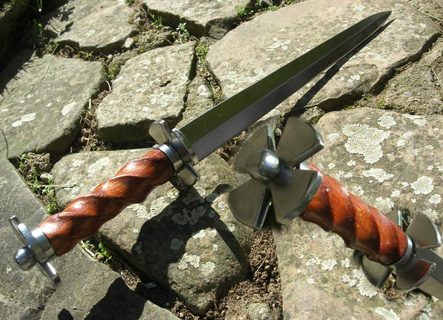
When it comes to short sidearms of the late Middle Ages, it can be said that just a few weapons are as iconic for this period as the so-called rondel dagger (German: Scheibendolch, French: Dague à Rouelles). The name of this weapon is derived from two characteristic discs (usually - but not always - circular in shape), one of which served as a guard and the other as the pommel of the dagger.
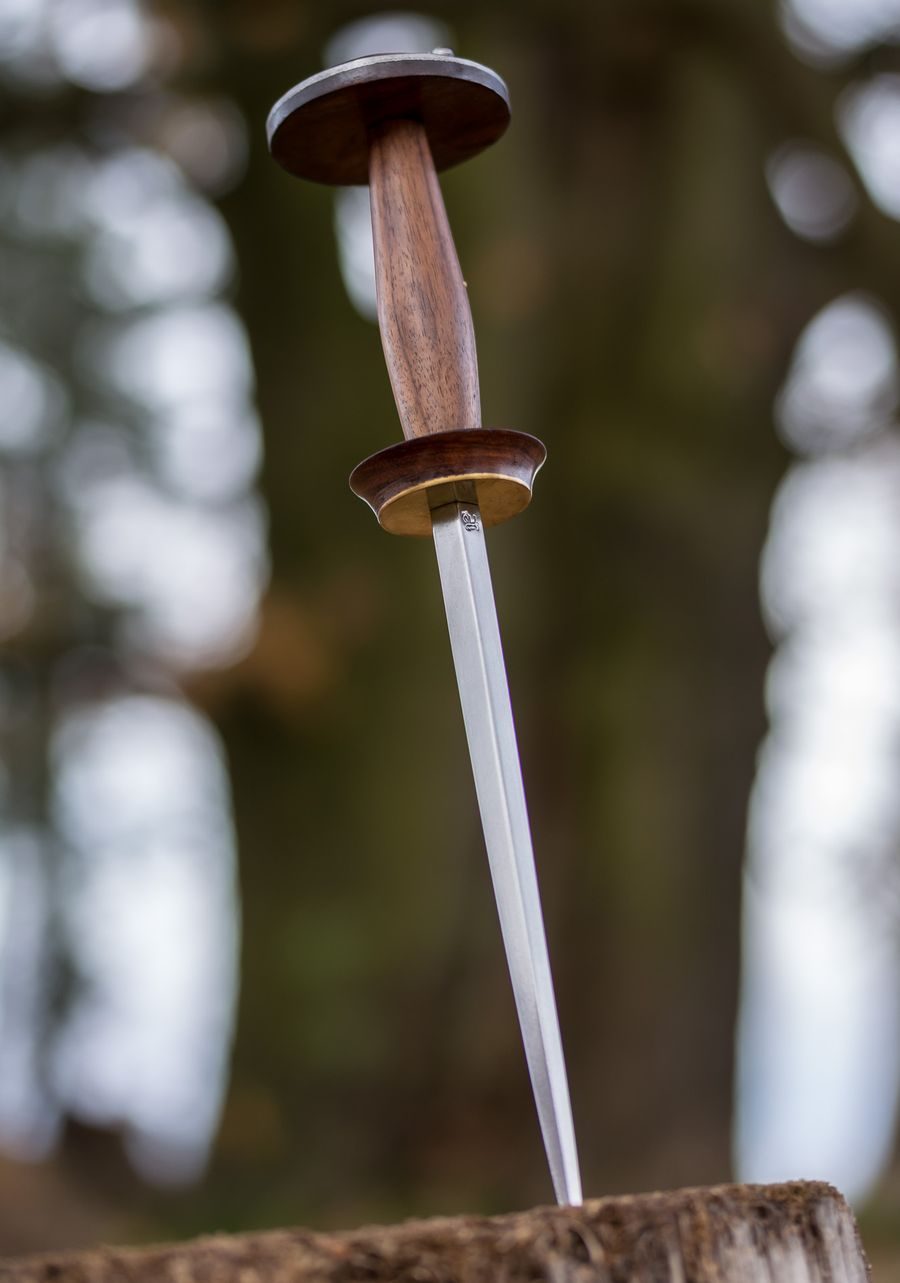
Unlike the so-called kidney dagger (also known as bollock dagger), the rondel dagger is somewhat younger in terms of weapon development. Its development took place in the 14th century in response to the progressive development of plate armour. From the construction of the dagger, it is evident that, unlike kidney daggers, it was primarily intended for what is known as the "icepick grip," where the point from the fist clenched on the grip points downward. The rondel dagger was primarily intended for thrusting actions, which is evident not only from the predetermined primary method of grip but also from the blade constructions – these blades always taper into a thin sharp point regardless of the width at the guard disc. The blade profile in cross-section was usually lens-shaped, triangular, or rhomboidal. The blade typically had one edge sharpened along its entire length and the other either only at the tip or even up to ¾ of the blade length. However, there are also daggers that had both edges sharpened along the entire length of the blade. Conversely, for daggers with a rhomboidal blade profile, it must be said that they actually did not have sharpened edges (and thus were not intended for cutting) but only had edges. The same was true for daggers with a blade profile in the shape of a cross or star, as they were not intended for cutting but only for thrusting.
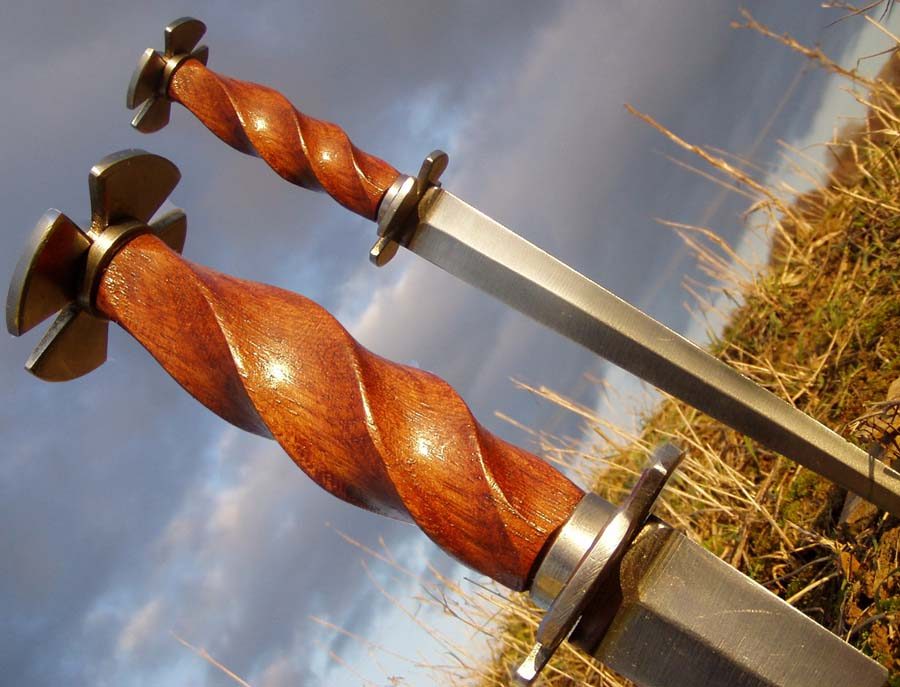
The concept of the rondel dagger envisioned thrusting combat techniques and ultimate strikes aimed at the joints of plate armour, visor gaps, and the groin, protected by maximum coverage mail, which the rondel dagger could penetrate if necessary.
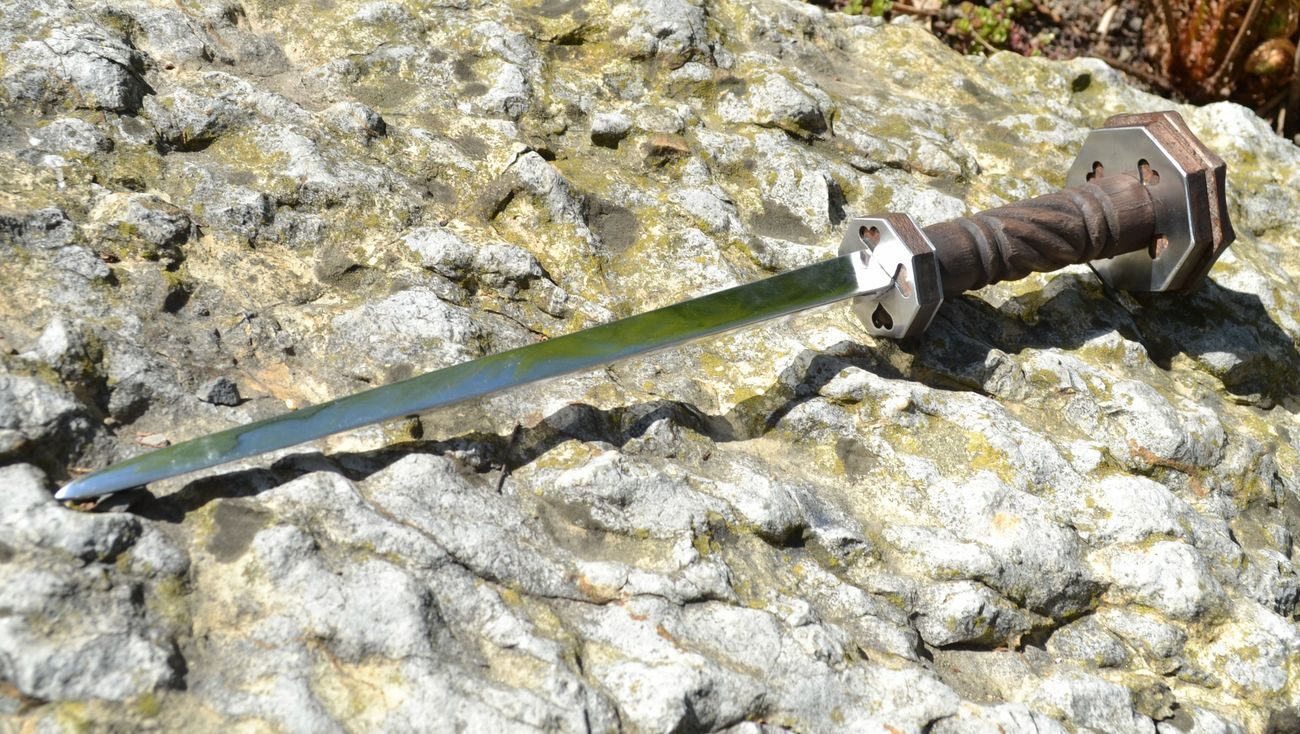
From the information provided, it might seem that the rondel dagger was purely a military weapon, intended for mounted man-at-arms and heavy cavalrymen in plate armour. In reality, rondel daggers were used across all layers of late medieval society, so they can be found not only in contemporary depictions of combat scenes or in fencing manuals but also in illuminations depicting everyday life. Rondel daggers can thus be easily found on the belts of burghers, merchants, and craftsmen.
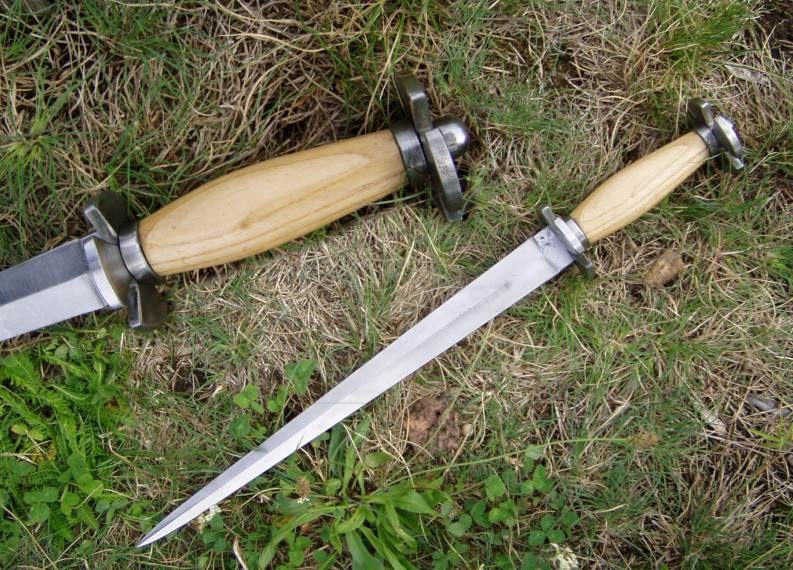
The overall length of this dagger type ranged from 35-60 cm, with the blade typically measuring 30-50 cm. The craftsmanship and possible decoration varied according to the owner's economic means and social status – from simple and plain designs to specimens adorned with engraving and gilding. Popular decorative features for these daggers included the guard discs, which could be intricately pierced, and the handles made of wood or bone, which were again adorned with carving or engraving. Some specimens featured a mushroom-shaped pommel (i.e., on the upper disc), which could also be made of wood or bone. The guard disc on such a dagger version could also have a so-called „sandwich structure“, meaning that a disc of wood or bone was inserted between two metal discs. However, there were also daggers made entirely of metal, including the handle construction.
Rondel daggers were still used in the first half of the 16th century, during which they were gradually displaced by other types of daggers from both functional and fashion perspectives.
And what to read next?

Rondel Dagger
When it comes to short sidearms of the late Middle Ages, it…
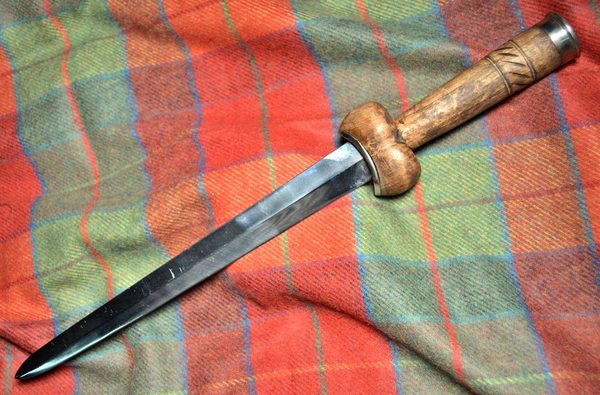
Kidney dagger – Bollock Dagger
The dagger was, alongside the knife, a basic and usually…

The Witcher
When Polish writer Andrzej Sapkowski finished the first…
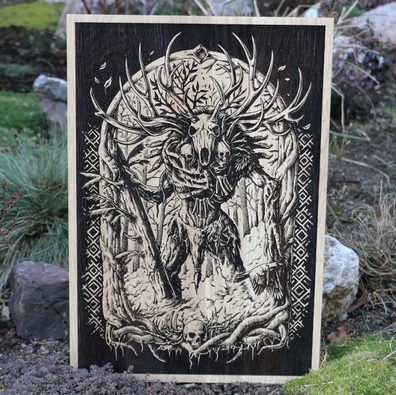
Leshy - Slavic forest spirit
Leshy - Slavic forest spirit


